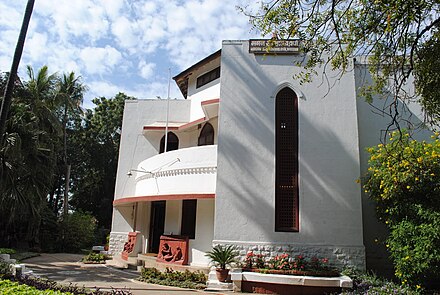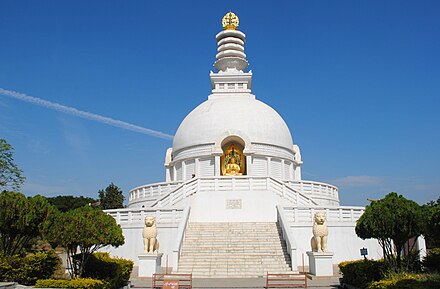Wardha - city
Wardha is a city of 126,000 people (2011) in Vidarbha. Founded in 1866, the town is now an important center for the cotton trade. It was an important part of Gandhian Era.
Understand
History
Hindu Kingdom of Berar
Little or nothing is known of the early history of the District, but we have a mention of the river Wardha so for back as the 2nd century BC. The early mention goes to Berar - the King of Vidharbha. The country of Vidarbha (Berar) was later divided into two (between Berar and his cousin Madhavansena), each ruling on one side of the river (Wardha).
Chalukya and Radhtrakuta Kings Wardha with the rest of Berar probably formed part of the Chalukya Rajput dynasty whose capital was situated in the modern Bijapur District and subsequently at Nasik and whose rule lasted from about 550 to 750 AD.
Copper-plate grants belonging to this dynasty have been found at Multai in Betul and at Deoli in Wardha. The Deoli plate is dated AD 940 in the reign of the king Krishna III; it records the grant of a village named Talapurumshaka in the Nagapura-Nandivardhan District to a Kanarese Brahman.
The Bahmani Kingdom Wardha was subsequently included in the territories of the Bahmani kings of Gul barga near Solapur and Bidar, who established an independent principality in 1351, and were so called because the founder of their line, elected after the revolt from Muhammad Tughlak, was either a Brahman or a Brahman's servant. Mr. Sir A. Lyall says : 'We may venture to describe roughly the Bahmani province of Berar as stretching from the Satpura range southward to Godavari river, from Khandesh and Daulatabad eastward to the Wardha river.'
The Imad Shahi Dynasty
There is and early mention of an invasion of Berar by the king of Gujarat in 1437 in which the Raja of Gondwana (across the Wardha) aided and abetted. This Raja must probably have belonged to the Chanda line. On the collapse of the Bahmani dynasty in 1518, Berar was ruled for a period by the Imad Shahi princes from their capital at Ellichpur, the founder of the dynasty being a Kanarese Hindu whom the governor of Berar had promoted to high office.
The Mughal Empire
The Ellichpur kingdom was crushedby the king of Ahmadnagar in 1572 after a separate existence of ninety years, and in about 1594 Berar was ceded from Ahmadnagar to the Emperor Akbar.
The Maratha Invasion
The tract west of the Wardha included in Berar was finally ceded to Nagpur in 1822, the forts of Gawilgarh and Narnala and some other territory in Berar being retroceded by the Bhonslas to the Nizam at the same time.
The Bhonsla kingdom
In 1765 the allied armies of the Peshwa and the Nizam marched through Wardha plundering the adjoining country, and burnt Nagpur in retribution for the dishonesty displayed by Janoji-I in his conduct towards both of them.
Formation of the District
Wardha continued to form part of the Nagpur District until 1862 under the British, when it was made a separate charge chiefly on the ground that Nagpur as it then stood was too large for a single District, and that the interests of the very valuable cotton industry in this part of the Wardha valley needed special supervision. The District headquarters were first located at Kaotha, near Pulgaon, but in 1866 they were removed to their present site, and the town of Wardha, named after the river, was built on the ground occupied by the hamlet of Palakwadi, the existing houses being levelled to admit of the new town being laid out on regular plan.
Sevagram
Sevagram is a small village near Wardha town (8 km). Mahatma Gandhi reached the village on 30 April 1936. He remained here for about five to six days. He called the villagers and the purpose of his visit and sought their permission to settle down here. He had no intention to keep anybody with him except his wife Kasturba. However slowly pressure of work necessitated permission to more colleagues till Sevagram Ashram also became a full-fledged institution.
He was 67 years when he came to Sevagram. In those days the village was surrounded by forest on all sides. Snakes and scorpions were a common feature. There was only one footpath or cart track to Wardha. No post-office or telegraph office existed. There is another village in this region named Shegaon, made famous by the residence of Saint Gajanan Maharaj. Hence Gandhiji's letters used to get misdirected. Therefore, it was decided in 1940 to name this village as "Sevagam" or the "village of service".
Get in
The easiest way to get to Wardha is via Nagpur. Wardha is 75 km from Nagpur and would take about an hour and a half to reach.
Get around
See
- Gitai Mandir. This temple is situated in Gopuri near Vishwa Shanti Stupa. This is a unique temple in India which has no deity and roof. It has just walls made of granite slabs on which 18 chapters of Gitai (Shrimad-bhagwad-gita in marathi) are inscribed. The wall enclosed a little beautiful park. This temple was inaugurated by Acharya Vinoba Bhave in 1980. Beside are two exhibitions about life of Acharya Vinoba Bhave and Jamnalal Bajaj.
- Kelzar Ganpati temple. The Kelzar Ganpati Temple is situated about 26 km form Wardha on the Nagpur road. This temple is situated on a hill & surrounded by the scenic beauty of forests & hills. The temple is historical place and its history goes back to "Vashishtha Purana". The place is also mentioned in "Mahabharata". The temple is situated near the "Bor National Tiger Reserve & Bird century".
- Magan Sangrahalaya (Museum). This museum was inaugurated by Mahatma Gandhi in 1938. It is situated in Maganwadi near Centre of Science for village. Purpose of construction of this museum is to spread awareness about research and development of rural industries, agriculture, dairy etc. various types of charkhas, khadi, hadicrafts by rural artisans, methods to promote swadeshi movement etc. are exhibited there.
- Paramdham Ashram. This ashram was established by Acharya Vinoba Bhave in 1934 on bank of river Dham with spiritual purpose. He also establish Brahma Vidya mandir in it. He started Bhoodan movement from here. Also starting point of "Bharat Chhodo Andolan" was this ashram.
- Sevagram Ashram (Bapu Kuti), +91-7152-284753, sevagram_ashram@yahoo.in. Old name of village Sevagram was Shegaon. After leaving Sabarmati ashram, Mahatma Gandhi stayed a few days in Wardha City at Bunglow of Jamanalal Bajaj. Thereafter, this ashram was built by him for Gandhiji at outskirts of wardha. Gandhiji arrived here in 1936 and stayed till his death in 1948. It is a group of huts used by Gandhiji, his wife Kasturba and other disciples. The premise is very calming. All the things used by Gandhiji and others are preserved here including his spectacles, telephone, notebook, tables, and mats. There is an exhibition of life of Gandhiji. Sevagram Ashram was the birth place of the Non-Cooperation Movement against British Rule in India. 2017-03-10
- Vishwa Shanti Stupa. Vishwa Shanti Stupa was a dream of Fujii guruji as called by Gandhiji. It is beside Gitai Mandir. It is a large stupa of white color. Statues of Buddha are mounted on stupa in four directions. It also has a small Japanese Buddhist temple with a large park.
Do
Eat
The best bakery of the town is "Nirmal Bakery". This bakery offers oven fresh breads, cookies and cakes. You can easily reach by addressing Nirmal Bakery in Wardha.
Samadhan is a snacks shop for samosas and aloo-bonda (best at its taste) also next to it there is a novelty juice shop with speciality of badam-shake.
Drink
Sleep
Stay safe
Go next
Wardha
2nd-order administrative division
Maharashtra
Primary administrative division

